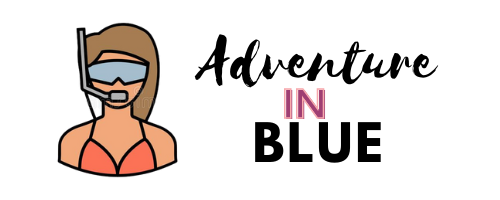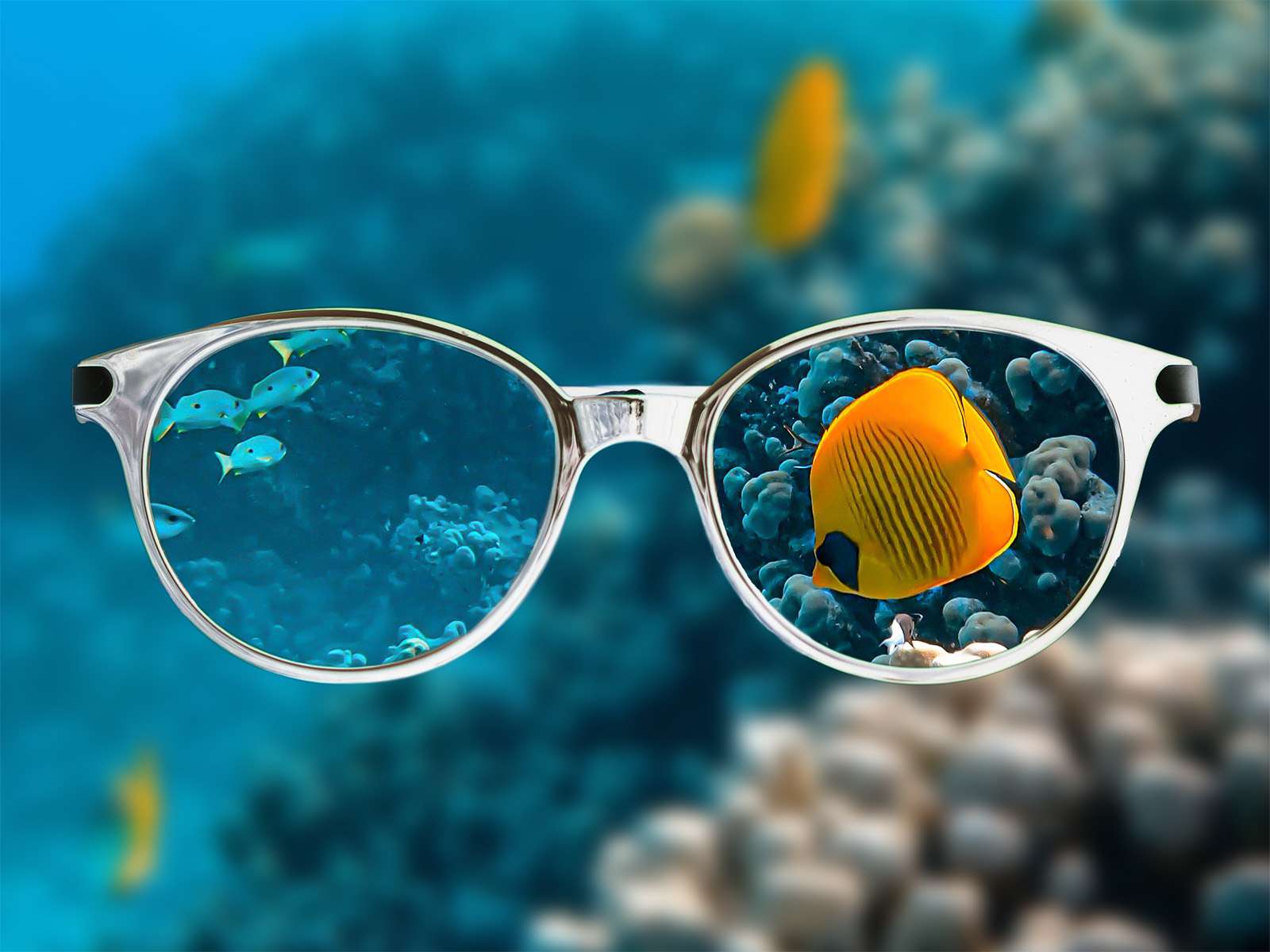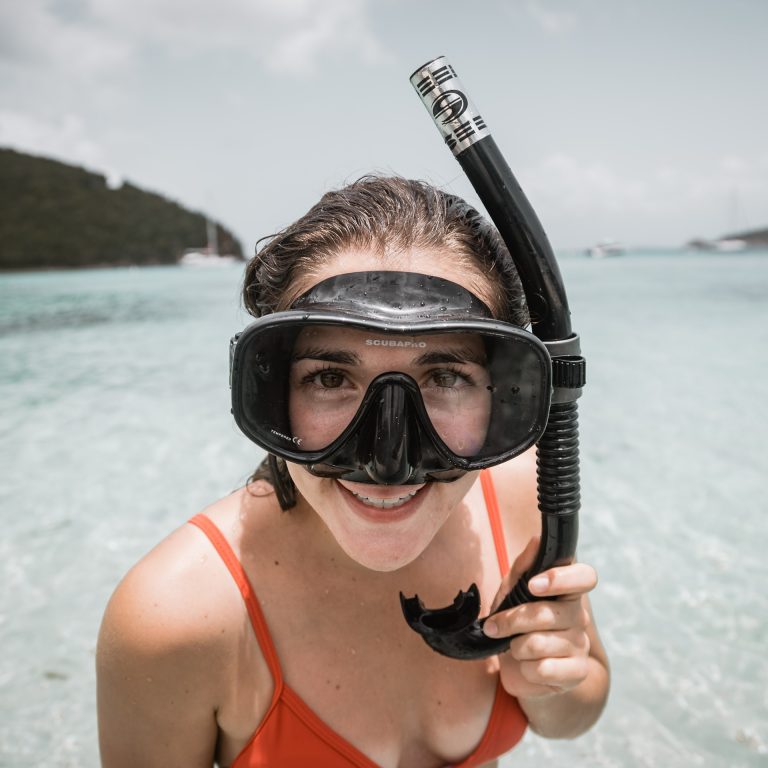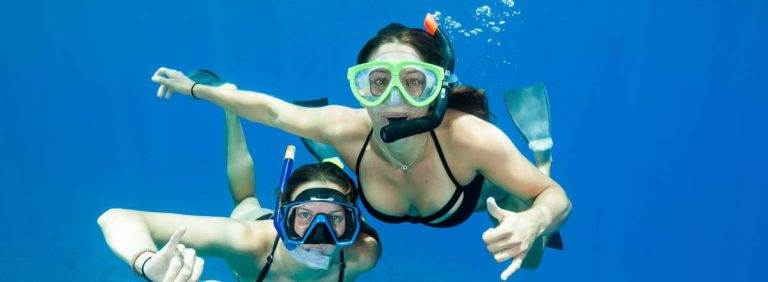A Quick Answer to Can You snorkel with Glasses?
Yes, You can easily snorkel with glasses. You may use your glasses prescription to add corrective lens inserts to a snorkel mask or wear a snorkel mask with its corrective lenses built-in; however, it’s preferable to modify an existing pair of glasses to fit a snorkel mask.
How to snorkel with glasses? 7 GREAT WAYS TO SEE UNDERWATER
When snorkeling, there’s just so much to see in the sea; fish, coral, rays, and sea turtles are just a few of the species that may be seen; however, if you’re like me and don’t have perfect eyesight, being able to snorkel while seeing beneath the surface might get a little more difficult.
It’s going to take a little creativity. While someone who wears glasses can snorkel, snorkeling with earpieces as they do on land isn’t advised because the mask seal will frequently be broken, and water will enter the mask. However, several different techniques to swim underwater while snorkeling goes beyond those mentioned above.
I’ve tried all these water strategies over the years to see what works and how much it costs. So, let’s look at how you can snorkel with glasses underwater, from the simplest to the most complicated.
Note: New to snorkel, Here is our Complete Guide about How to Snorkel Underwater?
1. Test your natural vision in a snorkel mask underwater
If your eyesight is only slightly impaired, you may not need to wear glasses or other corrective lenses while snorkeling. Water magnifies what you see by about 25%, making it easier to see objects that are far away. (Consider how printed text on a piece of paper appears larger if you set a glass of water on top of it and look down through the top of the glass.) [source].

If you have any issues with your vision while snorkeling, don’t worry too much. If you can see well enough on land while missing some vision sharpness in the water, your Snorkeling Vision Correction procedure should help.
If at all feasible, you should test this for yourself before going to the beach to see if you’ll be able to see as you want or need to instead look for something else on this list. If you have a snorkel mask at home, you can put it on and go for a swim (or even a decent-sized bathtub) and examine an item located at various distances.
You won’t be able to tell as well in a pond with limited distances how the water affects your vision’s focus as you would in an ocean with infinite distances. Still, you should be able to tell if the thing is clearer (and sharp enough) than the same distance above the water.
Although you won’t always need to look at something from a mile away because visibility underwater is typically lower than on land, most of what you’ll want to see during an average recreational snorkeling dive will be within 50 feet / 15 meters.
Alternatively, if you’re at the beach and don’t want to use someone’s mask, go into some safe shallows and check how things look underwater. If things aren’t going as well as you would hope, a local dive shop (but not necessarily a simple snorkel rental shack on the beach) may be able to assist you with several of the other alternatives on this list.
You Can Also Check our Detailed guide about What snorkel Gear should i Buy?
2. Wear contact lenses while snorkeling
This is most likely your first response since it’s so simple. However, wearing contacts while swimming in any situation is strongly discouraged by medical experts. Some people realize that it’s not always feasible for everyone to avoid touching each other. They offer a few recommendations if you can’t avoid wearing them to ensure your eyes are safe and you have a good time.
In the first place, soft contacts seldom produce discomfort due to pressure, but you should avoid wearing hard contacts or gas-permeable versions while diving underwater. When you surface, the pressure of the water above you may cause hard/gas-permeable contacts uncomfortable and can even induce blurry vision, contacts stuck to your eyes, or other issues—wearing these contact lenses when snorkeling generally entails sticking to the surface to avoid problems.
If you need to take your mask off for any reason, be sure to close your eyes tightly to prevent water from entering your eye. We can describe this as “duh,” but it’s good to remember so you don’t have something similar to your contact flying away or being absorbed into another section of your eye (which is just the worst) or an infection.
If you get some water in your eye, remove your contacts as soon as possible. Even if you didn’t feel any water in your eyes, remove your lenses for safety after you’ve finished swimming.
If you’re cleaning your contacts, it’s ideal for soaking them in contact solution for at least 24 hours; if not, completely discard the pair of contacts you were wearing and start over [source]. If you wear daily disposables, you might want to reconsider using chlorine. Naturally, ocean water won’t be completely pure, so it’s only prudent to avoid catching any serious eye infections [source].
That is why it’s a smart idea to bring your contact lens case, solution, and anti-bacterial eye drops with you so that you can quickly swap to glasses once you’ve finished snorkeling. Finally, I believe the dangers of a serious eye infection or other issues are too high to justify the convenience of wearing contacts while snorkeling; therefore, I advise selecting another alternative on this list. For more about how snorkeling affects your contacts, visit the links below. Can You Snorkel with Contacts? 3 Critical Eye-Saving Answers.
3. Find snorkel mask corrective lens inserts
If the natural lensing of the water doesn’t correct your vision (see option #1 above), specialized inserts for snorkel masks can help you see better without requiring glasses or contact lenses. These are particularly useful if you already have a snorkel mask that suits you well and want to keep using.
Another advantage of these lenses is that you may typically purchase one for each eye. So, if your left and right eyes don’t have the same prescription, you can get separate inserts to match. These lenses are just like your glasses’ regular lenses in that they generally stick inside your mask and refract what you’re looking at just as your glasses’ do.
The most popular form of these inserts is bi-focal, which means they’re tiny strips of adhesive lens that you place lower in your field of vision. This will work wonderfully if you have far-sightedness and need corrective lensing for closer objects (or checking your watch, etc.).
However, the difference is minor if you have nearsightedness and require general lensing for everything beyond arm’s length. Farsighted individuals may benefit from something like DiveOptx (Amazon) because it does not include an adhesive and can be reused and removed, and this is a significant advantage.
These lenses may be installed in the same manner as standard diving lenses. First, put on your snorkel mask, and then make a whiteboard marker or small square of tape outside your mask where you want to have magnification. After that, clean the inside of your mask thoroughly and let it dry. Then, stick the lenses to the inside of your mask where you’ve drawn an eye path and smooth them from center to edges to eliminate any air pockets. It’s a wonderful thing that sight is!
Check out our complete guide of 8 Best Snorkel Mask.
4. Pick up a snorkel mask with drop-in corrective lenses
If you’re looking for a general corrective lens (not something in a bi-focal format), an optical dive mask with corrective lenses preinstalled into the frame is your best bet. This is because it’s a good balance between price and difficulty.
The prices can vary considerably, but if you’re a casual snorkeler who enjoys the occasional calm float, you can acquire a mask with the correct set of lenses for your eyes for around $60. If you’re not a snorkeler, this may be a basic mask. However, it might be a fantastic choice if you don’t snorkel all that often. If so, Promate’s optical mask is a no-fuss choice that makes it easy on Amazon (you can also check complete article about best snorkel mask here) by allowing you to buy the mask and choose your lenses in one step.
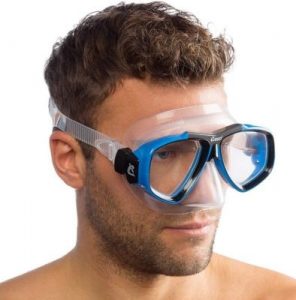
If you snorkel regularly or enjoy scuba diving while out on the sea, a more durable mask with tempered glass and other nice-to-haves may be more of an investment, often costing around $75 to $200. However, the ability to view the minute aspects of the aquatic environment through a mask that you enjoy is well worth it over time.
Cressi’s Focus line is a wonderful place to begin learning about these masks from a reputable, well-established snorkel/scuba maker. Cressi is recognized for producing strong snorkeling and scuba masks, so it’s great news that they’ve branched into optical masks. A Cressi Focus mask in various hues and separate Focus lenses can be found on Amazon through those links. It’s our top pick for the best drop-in optical snorkel mask for the average person because of its tempered glass inserts, easy availability of optical lenses, good manufacturing in mask materials and straps/buckles, and reasonable price.
The second factor is that with the development of snorkel technology, many manufacturers are now offering corrective full-face snorkels with built-in prescription lenses., like the Vista Vue II Prescription Snorkeling Mask.
Regardless of the mask type you choose, you’ll need to know what lens power to order. Find your glasses prescription (or call your optometrist’s office if you can’t find it, not that I have any personal experience with this or anything!) and look for the SPH or SPHERE number for each eye.
The amount of light needed to show contrast effectively is around -1.5 or -4.0, and that’s the figure you’ll use when ordering a snorkel lens for your corrective mask. Ensure you get the correct number for the right eye and include the negative sign if necessary! Fortunately, drop-in optical masks are frequently available for hire. You’ll almost certainly need to visit an open dive shop near your location (call first to check if they have them available); The best tour operators aren’t likely to have them on hand. They’ll generally set you back a few extra bucks to borrow, but it will be well worth it.
5. Send in your favorite mask to have bonded lenses installed
If you already have a mask that you enjoy and none of the other alternatives suit you, you can submit your snorkeling mask to a firm specializing in bonded lenses for snorkel masks.
The inside of your current snorkel mask is lined with flat lenses that are subsequently bonded to it using your prescription. The drawbacks are that the direct influence on your mask is minor, but you get a set-up that allows you to go in and see clearly without glasses or contact lenses. However, they will come at a cost, and if the glasses aren’t precisely the same size or shape as your mask, cleaning may be difficult in some areas. And costs usually range from $200 to $300.
Finally, if you have a particularly strong prescription or significant astigmatism, these lenses may not work 100% for you, but one of the following options can help.
If you choose an optical mask with drop-in lenses, you’ll probably spend less money (see option #4), You may also use a painting tarp over your mask, or you can use any other type of material.
6. Send in your favorite mask to have integrated lenses installed
A single contact lens is attached to the mask, similar to the previous option. Instead of a manufacturer creating separate lenses bonded to your snorkeling mask, they build an entirely new lens based on your glasses prescription and put it straight into your snorkel mask.
The major advantages of this option are that you’ll get a seamlessly integrated lens in your mask that works directly with your prescription. This is a significant plus if your eyes haven’t changed recently. However, it is generally one of the most costly alternatives on this list (expect to pay $200-$300), and if your eyes change in the future, you’ll need to get a new lens made from scratch. If you decide to upgrade to adaptive or integrated lenses, you may save money (maybe even half) by purchasing a new optical mask with drop-in lenses (option #4), but if you don’t want to part with your mask, there are many options for you.
7. Modify a pair of your old glasses to fit in your snorkel mask
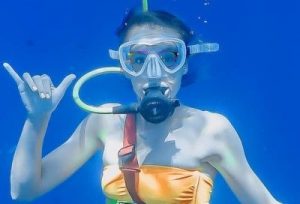
Finally, you can connect one of your current pairs of glasses to your snorkel mask with a little creativity and a few minutes. Depending on the mask you’re using, and what you have on hand, your methods will vary somewhat. Here’s everything you’ll need:
- An old pair of glasses. You won’t want to wear your old ones because we’ll make some changes. Because the lensing effect of water (see option #1 above) will likely make up for any decline, it’s probably OK if the prescription is a bit out of date. If your prescription is the same power for both eyes, you can purchase a cheap pair of readers (or “cheaters,” as my father-in-law refers to them) from a pharmacy.
- A glasses screwdriver
- A tube of superglue
- Either a whiteboard marker or some tape (painter’s tape is ideal since it’s easy to see and remove)
Attach a suction cup (optional) to the lens if you use a single-lens or full-face snorkel mask.
Here’s how to add glasses to your snorkel mask:
- If you have a single-lens mask (one whole piece that stretches across the front of the mask, rather than two pieces for each eye) or a full-face mask (one lens),
- Put on your mask and mark the outer edge of each eye, looking out at the world with a dot. To represent the center of each eye, use the whiteboard marker (or a tiny square of tape) to place a dot on the outside of your mask.
- Remove your mask and clean the inside of the mask lens, allowing it to dry fully after marking.
- Remove the earpieces from your glasses by unscrewing the tiny screws on each side of the frames with a screwdriver. You should be left with only the front frame and lenses.
Now it’s time to connect the glasses frame to the mask. You have two options for connecting the mask and glasses frame:
- My preferred method is to utilize a suction cup, which allows me to remove the glasses later when they’re convenient. It’s also useful for cleaning and if my prescription changes significantly. If you have a suction cup, apply a little of the superglue to the bridge of your glasses frame and press it firmly into the back of the suction cup. When the glue has dried, position the suction cup/glasses hybrid on the inside of your mask, following the dots you made earlier to indicate where the frames should rest.
- If you don’t have a suction cup, affix the glasses to the inside of your mask directly on the mask lens with a dab of superglue applied across the bridge of your frame. Firmly press and allow to dry.
- Remove the whiteboard marker dots (or the tape) and clean the outside of the mask thoroughly. You’re ready to go!
If you have a dual-lens mask (which has two separate defined lens areas, one for each eye), follow the manufacturer’s instructions for cleaning.
- Use the whiteboard marker to make a dot outside your mask for each eye’s center. Attach the small square of tape to the inside of your mask and place a dot on it for the center of each eye.
- Remove your mask and thoroughly clean the inside of the mask lens, allowing it to dry fully after you have completed your markings.
- Remove the lenses from your backup pair of glasses. It might be possible to do it with the glasses screwdriver if that’s what you’re using, but you may have to pop them out along the edges. After removing the lenses, make sure you remember which is which.
- Glue a tiny dot of superglue on the outside of each lens where it is most convex and press them into the inside of your mask, using the dots you made earlier to guide them. Allow the glue to dry fully.
Wipe off the whiteboard marker dots (or remove the tape) and clean the outside of the mask thoroughly. You’re ready to go!
Of course, this is a shoe-string approach. But it’s inexpensive, and it might be beneficial for individuals with strong prescriptions or situations such as astigmatism that other optical mask choices may not be able to compensate for as easily.
Conclusion
Snorkel with glasses has its difficulties, but several solutions are available to help spectacled snorkelers get all of the pleasures this underwater activity offers. Your eyesight, budget, and how much time you want to spend snorkeling and diving will determine the best solution for you.
